News
Home > News>SIXTH INTERNATIONAL CONFERENCE ON URBAN EARTHQUAKE ENGINEERING
SIXTH INTERNATIONAL CONFERENCE ON URBAN EARTHQUAKE ENGINEERING, Tokyo
 |
| Group photo |
1. Introduction
CUEE hosted its Sixth International Conference on Urban Earthquake Engineering on 3rd and 4th March 2009 at the Marunouchi Building in downtown Tokyo. This was our first international conference after initiating the “International Urban Earthquake Engineering Center for Mitigating Seismic Mega Risk” Global-COE Program, successor to the previous “Evolution of Urban Earthquake Engineering” 21st Century COE Program here at Tokyo Institute of Technology. On the occasion of this recent conference 342 academics and professionals, including 95 researchers from abroad, took part (Photos 1-3).
 |
 |
 |
| Photo 1: Prof. K. Tokimatsu (Conference Chair) | Photo 2: Professor J. Moehle (First Keynote Speaker) | Photo 3: Main Conference Hall |
2. Opening Addresses
The newly instituted G-COE Program works to mitigate the seismic mega risk with which earthquake-prone countries throughout the world are today confronted. We shall endeavor to promote and strengthen the educational aspects of the 21st century COE Program, as well as to enhance the existing international education and research network in this essential field. We believe it is vital to train researchers as specialists in education and research and likewise as professionals able to manage all aspects of seismic risk in terms of earthquake disaster prevention at an international scale. At the same time, under the auspices of the Center of Urban Earthquake Engineering (CUEE) at Tokyo Institute of Technology, advanced research activities in the field of Urban Earthquake Engineering emphasize the creation of earthquake-proof societies, as well as studying regeneration and recovery techniques. In order to disseminate findings, talent, knowledge, and technology via our international conferences, workshops and exchange programs with their global focus, CUEE continually seeks to define its role as a headquarters for urban earthquake engineering worldwide. Prior to the March conference, a day was devoted to our jointly sponsored Young Researchers Workshop managed between CUEE and PEER (Pacific Earthquake Engineering Research Center), key partner of CUEE (Photo 4). The details of the workshop will be reported elsewhere in this Newsletter. The conference opened at 10 AM on 3rd March with a welcome address by Professor K. Tokimatsu (Tokyo Institute of Technology), director of the G-COE Program, given in the Main Conference Hall. Then Professor R. Boulanger (University of California, Davis) reported on the jointly sponsored Young Researchers Workshop we had held the previous day, highlighting our expectations for the special CUEE educational agenda directed to younger researchers. Throughout the conference postgraduate students from Tokyo Tech served to assist the main CUEE Office personnel (Photo 5).
 |
 |
| Photo 4: Young Researchers Workshop | Photo 5: Registration |
3. Keynote Speeches and Poster Session (Morning of First Day)
In the morning session, the following Keynote Speeches were delivered: 1) by Dr. K. Campbell (ABS Consulting): “Prediction for Engineering Seismology”, 2) by Professor I. Nakabayashi (Tokyo University): “Strategic Studies for Mitigation and Recovery from Mega-earthquake in Major Cities”, and 3) by Professor J. Moehle (Pacific Earthquake Engineering Research Center): “Newest Technology for Controlling Building Damages”. Dr. Campbell introduced a new method of predicting earthquake motion that depends above all on the distance from the epicenter. Professor Nakabayashi enumerated various kinds of risk management in the case of occurrence of a major earthquake in a metropolitan area. He stressed the need to analyze commuter traffic flow with people working in the city center attempting to return home en masse, as well as options for spending a single night at the workplace instead. Professor Moehle showed us samples of construction systems currently being used for high rise apartment areas in cities in the Western U.S., emphasizing the importance of designing for seismic mega risk in such localities. Just before adjournment, a Poster Presentation was held in the auditorium foyer (Photo 6). Some 18 posters were displayed on each day, submitted mainly by younger researchers for the pre-announced CUEE competition “Best Poster Presentation Award for Young Researchers” judged by senior researchers. A lively discussion ensued before the lunch break.
 |
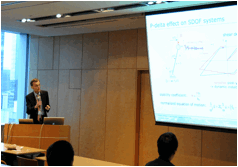 |
| Photo 6: Poster Session | Photo 7: Parallel Session |
4. Parallel Sessions and Welcome Party (Afternoon of First Day)
Following the lunch break, three parallel sessions took place in different venues (Photo 7). On the first day 10 to 12 presentations were held on each of the following topics: Engineering Seismology I, Concrete Structures in Building Engineering, and Analyses Related to Risk Management. Invited speakers and participants mainly from outside Tokyo Institute of Technology convened in these sessions, where thought-provoking discussions were stimulated.
We had two further Keynote Speeches in the afternoon by Professor K. Kawashima (Tokyo Institute of Technology) and Dr. S. McCabe (Network for Earthquake Engineering Simulation). Professor Kawashima reported on the dynamic demolition vibration testing of actual-size bridge footings at the E-Defense Facility in Miki City, Hyogo prefecture. The slides of this bridge support demolition under dynamic compression stress produced a strong impact on his audience. Dr. McCabe presented various dynamic member experiments by U.S. universities at the NEES facilities, as well as a large-scale seismic qualification test of actual structures (Photo 8). Following these speeches, CUEE held a welcome party in the foyer (Photos 9 and 10). At the beginning of the party, Professor K. Iga, President of Tokyo Institute of Technology, outlined the significance of our G-COE program and requested the cooperation of all. Invited speakers, conference participants and the organizers of the conference enjoyed this chance for informal socializing.
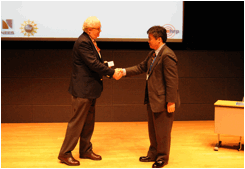 |
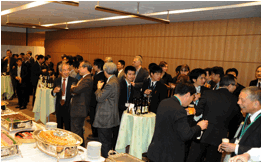 |
| Photo 8: Professors S. McCabe and J. Niwa | Photo 9: Welcome Party |
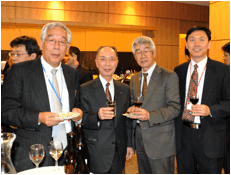 |
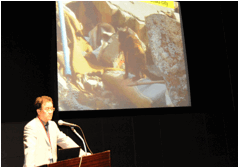 |
| Photo 10: Left to right, Professor C. Miki, President K. Iga, Professor T. Ohmachi, and Professor H. Hsu | Photo 11: Dr. W. Yayong |
5. Parallel Sessions (Second Day)
The day’s initial parallel sessions dealt with: Design and Standards, Engineering Seismology II, and Concrete Structures in Civil Engineering. In the Design and Standards session, Professor W. Yayong (China Academy of Building Research, Photo 11) reported on building damage sustained in the Wenchuan Earthquake and emphasized a life and death situation dependent upon whether brick school buildings collapsed or not. He insisted that staircases must be secured zones. Photographs of damaged buildings as well as mudslides from the surrounding mountains that little by little had buried towns in the region made an especially strong impression.
Base Isolation/ Vibration Control, Geotechnical Earthquake Engineering I, and Bridge Structures sessions followed, and in the course of the afternoon Steel Structures I and II, Geotechnical Earthquake Engineering II and III, Human Behavior and Tsunami sessions ensued. Professor G. Deierlein (Stanford University) spoke in the Base Isolation / Vibration Control session about controlled rocking and replaceable energy dissipating fuses in shaking experiments and went on to describe tests at the E-Defense Facility projected for this summer. Professor J. Hajjar (University of Illinois at Urbana-Champagne) explained analysis of damage assessment methods and management of urban infrastructure in case of earthquake. Professor S. Kato (Toyohashi University of Technology) made a presentation on his “Trial for Seismic Fragility Evaluation of a Large Lattice Dome Supported by Buckling Restrained Braces”. During the interval between morning and afternoon sessions, quite a lively exchange based on the Poster Presentation equaled that of the first day.
6. Keynote Speeches and Closing Session (Afternoon of the Second Day)
Professor J. Bray (University of California, Berkeley, Photo 12) and Professor S. Mahin (University of California, Berkeley, and Director of PEER, Photo 13) made the final Keynote Speeches. Professor Bray talked about effective design strategies for buildings on or near surface faults, insisting on the need for structures designed to promote low-risk status in the vicinity of superficial layer faulting. Since in certain areas of the U.S., building construction on active faults is prohibited, he discussed how Japan might manage this kind of situation. He cited damage reports from the Wenchuan Earthquake, including persuasive examples that highlighted the correlation between building collapse rates and distances from known surface faulting.
Then, Professor Mahin demonstrated a number of research approaches for the sustainable development of earthquake-proof construction, such as the design of a vibration control system using a friction pendulum, the implementation of a rocking foundational system, and the concept of self- centering RC bridge supports.
In the closing session, Professor R. Boulanger (Photo 14) announced and congratulated the four winners (two international/ two Japanese) of the “Best Poster Presentation Award for Young Researchers” (Photo 15). Professor Bruneau (Photo 16) recapped our expectations for the G-COE program and Professor Midorikawa (Photo 17), Deputy Leader of CUEE, concluded the conference by expressing deep gratitude to all participants for their attendance and also requesting their continued cooperation. The very last event to be held was a commemorative photo shot of conference participants and organizers.
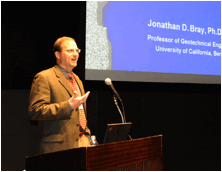 |
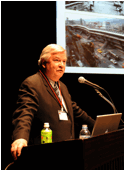 |
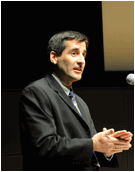 |
| Photo 12: Professor J. Bray | Photo 13: Professor S. Mahin | Photo 14: Professor R. Boulanger |
 |
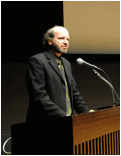 |
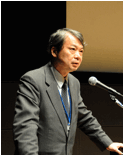 |
| Photo 15: Best Poster Award: recipients with Professors Tokimatsu and Boulanger | Photo 16: Professor M. Bruneau | Photo 17: Professor S. Midorikawa |
7. Conclusion
Thanks to everyone who attended, CUEE was able to conclude its Sixth International Conference, the first under the auspices of our new G-COE, with 142 papers given by 138 presenters and a total of 342 participants. Many of the invited speakers were good enough to express the opinion that this conference had afforded a productive occasion for all. Similarly, CUEE wishes to extend heartfelt gratitude to all who thus supported the Sixth International Conference and, once again, to request the continued warm support of all in its future endeavors.
